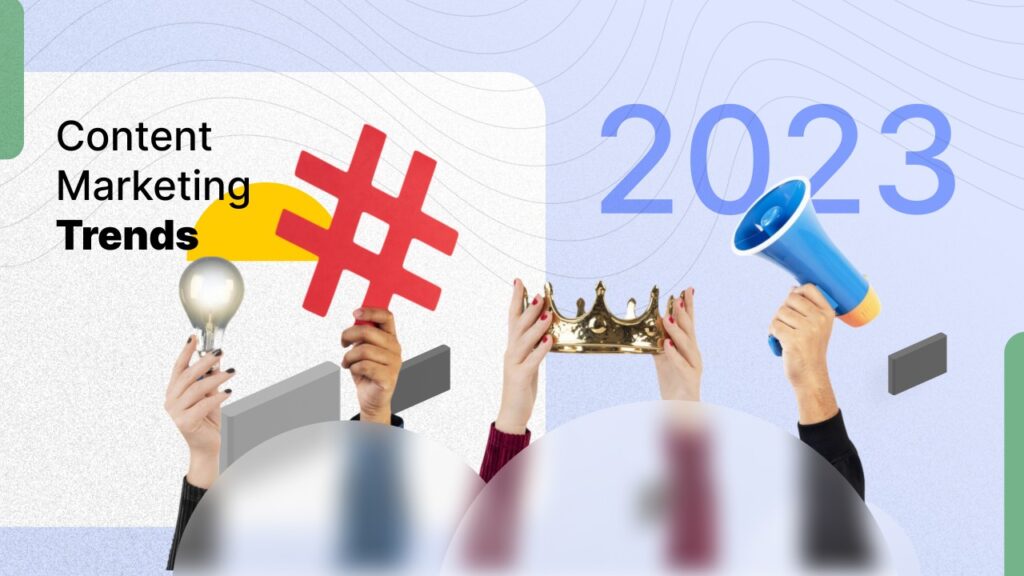Content Marketing Trends to Watch in 2023

Introduction
Content marketing continues to be a dynamic and evolving field. As we step into 2023, it’s essential for businesses and marketers to stay ahead of the curve by understanding and implementing the latest content marketing trends. In this blog post, we’ll explore the key content marketing trends to watch in 2023 that will shape the way brands connect with their audiences and drive growth.
- Video Content Dominance
Video content has been on the rise for several years, but in 2023, it’s expected to take center stage. With the widespread availability of high-speed internet and the popularity of platforms like YouTube, TikTok, and Instagram Reels, video content is becoming the preferred medium for many consumers. Brands that embrace video marketing will have a competitive edge. This includes not only traditional video ads but also live streaming, interactive videos, and short-form video content.
- Content Personalization at Scale
Personalization is no longer a novelty; it’s an expectation. Consumers want content that speaks directly to their needs and interests. In 2023, the trend is toward hyper-personalization, utilizing AI and machine learning to deliver individualized content experiences. This includes personalized product recommendations, email marketing, and website content tailored to each user.
- Voice Search Optimization
As voice-activated devices like smart speakers and virtual assistants become more common, optimizing content for voice search is crucial. People tend to use different phrasing in voice searches compared to text-based searches, so adapting your content to accommodate natural language queries is essential. Featured snippets and concise, conversational content will be key to voice search success.
- Interactive Content
Interactive content, such as quizzes, polls, surveys, and calculators, engages users on a deeper level. It encourages active participation rather than passive consumption. Interactive content not only captures attention but also provides valuable data on user preferences and behaviors, aiding in better-targeted marketing efforts.
- Sustainability and Purpose-Driven Content
Consumers are increasingly concerned about the environmental and social impact of the brands they support. Brands that take a stand on important issues and incorporate sustainability into their messaging will resonate with conscious consumers. Authenticity is crucial; consumers can easily spot greenwashing. Incorporating sustainability and purpose-driven content into your brand’s identity and storytelling can foster stronger connections with your audience.
- Long-Form Content for SEO
While short-form content like blog posts and social media updates still have their place, long-form content is gaining traction for SEO purposes. In-depth articles, guides, and whitepapers can provide comprehensive solutions to users’ queries, making them more likely to rank well in search engines. Long-form content also allows brands to showcase their expertise and authority in their respective industries.
- Content Across the Buyer’s Journey
Content marketing isn’t just for attracting new customers. In 2023, brands will recognize the importance of creating content that caters to every stage of the buyer’s journey, from awareness and consideration to conversion and retention. Providing valuable content at each touchpoint can lead to increased customer loyalty and lifetime value.
- AI-Driven Content Creation
Artificial intelligence is transforming content creation. AI tools can generate content, optimize headlines, and even assist in content editing. While AI can’t replace human creativity and storytelling, it can significantly streamline content production processes and help marketers analyze data to refine their strategies.
- UGC (User-Generated Content) Integration
User-generated content, such as reviews, testimonials, and social media mentions, provides social proof and authenticity that traditional marketing content can’t replicate. Brands will continue to encourage and showcase UGC as a part of their content strategies, leveraging the power of happy customers and brand advocates.
- Augmented Reality (AR) and Virtual Reality (VR)
AR and VR are creating immersive content experiences. Brands are using AR for virtual try-ons, interactive product demonstrations, and enhancing the shopping experience. VR is being utilized for virtual tours, events, and training. These technologies are making content more engaging and memorable.
- Ephemeral Content
Ephemeral content, which disappears after a short time (e.g., Stories on Instagram and Snapchat), encourages FOMO (fear of missing out) and real-time engagement. Brands will continue to use ephemeral content to showcase behind-the-scenes moments, promotions, and limited-time offers.
- Content Accessibility
Accessibility in content is not only a legal requirement in many regions but also a moral imperative. Brands will need to ensure that their content is accessible to individuals with disabilities, including those with visual, auditory, or cognitive impairments. This includes providing alt text for images, closed captions for videos, and accessible website design.
Conclusion
In 2023, content marketing will continue to evolve, driven by technological advancements and changing consumer behaviors. To stay competitive and effectively reach and engage their target audience, businesses must embrace these content marketing trends. Whether it’s through video content, personalized experiences, interactive elements, or sustainability initiatives, the key to success in the coming year lies in staying adaptable, innovative, and audience-focused. By keeping a close eye on these trends and adapting your strategies accordingly, your brand can thrive in the ever-evolving landscape of content marketing.